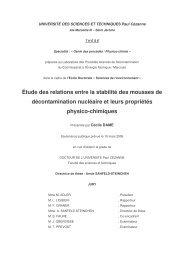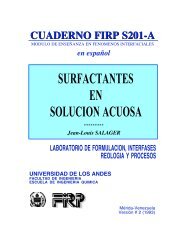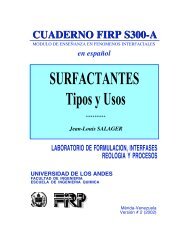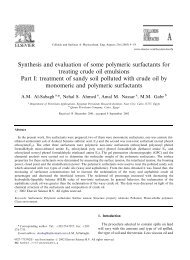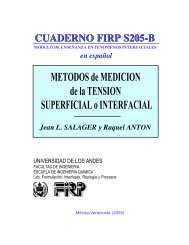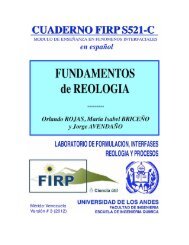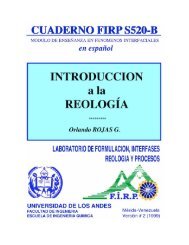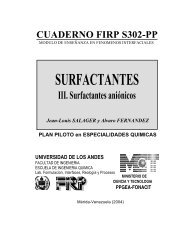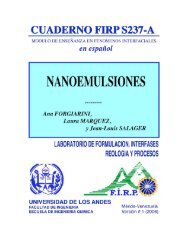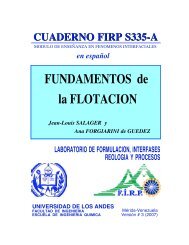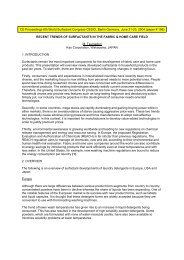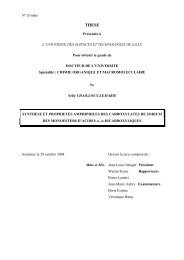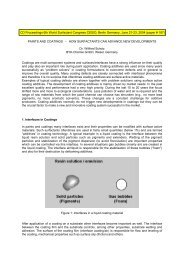Solubilization-emulsification mechanisms of detergency
Solubilization-emulsification mechanisms of detergency
Solubilization-emulsification mechanisms of detergency
Create successful ePaper yourself
Turn your PDF publications into a flip-book with our unique Google optimized e-Paper software.
C.A. Miller and K.H. Raney/Colloids Surfaces A: Physicochem. Eng. Aspects 74 (1993) 169-215 203<br />
(a C 30 branched hydrocarbon) and triolein.<br />
Also, hydrocarbon-fatty acid (or alcohol) soils<br />
<strong>of</strong> varying composition have been studied in<br />
which both carbon- 14 and tritium labels are<br />
utilized to allow the discrimination <strong>of</strong> removal<br />
<strong>of</strong> both components. The following are results<br />
<strong>of</strong> fundamental <strong>detergency</strong> studies using some<br />
<strong>of</strong> these soils, which were performed to allow<br />
correlation to the phase behavior and dynamic<br />
contacting studies described above.<br />
9. Fabric <strong>detergency</strong> - non-polar<br />
hydrocarbon soils<br />
Results <strong>of</strong> radiotracer <strong>detergency</strong> studies <strong>of</strong><br />
removal <strong>of</strong> hexadecane from 65/35 permanent<br />
press polyester-cotton fabric are shown in Fig.<br />
37 [18]. This soil can be considered a model for<br />
non-polar hydrocarbon-based soils such as<br />
lubricating oils. The washing solutions<br />
contained 0.05 wt.% surfactant, resulting in a<br />
fabric-to-soil weight ratio <strong>of</strong><br />
Fig. 37. Removal <strong>of</strong> n-hexadecane from 65/35<br />
polyester-cotton fabric using 0.05 wt.% aqueous<br />
solutions <strong>of</strong> C 12E 4 and C 12E 5 [18]. The arrows show<br />
the cloud point temperatures <strong>of</strong> the surfactants.<br />
Reprinted with permission <strong>of</strong> Academic Press.<br />
40/1 and a surfactant-to-soil ratio <strong>of</strong> 9/1.<br />
Triethanolamine (50 ppm) was included as a<br />
buffer, and no water hardness was present. The<br />
washing time in the Terg-0-Tometer was 10<br />
min.<br />
Of particular interest in these studies was the<br />
effect <strong>of</strong> temperature and non-ionic alcohol<br />
ethoxylate surfactant structure on the levels <strong>of</strong><br />
soil removal. As shown in Fig. 37, a strong<br />
dependence on temperature was observed with<br />
the highest levels <strong>of</strong> soil removal occurring<br />
almost 200C above the cloud point <strong>of</strong> the<br />
washing solution, a temperature regime in which<br />
the washing solution structure is a liquid<br />
crystalline dispersion. In fact, the optimum<br />
<strong>detergency</strong> temperature (ODT) in each case<br />
occurred very near the PIT <strong>of</strong> the<br />
water-surfactant-hexadecane system. Although<br />
not shown in Fig. 37, very poor <strong>detergency</strong><br />
occurred in the temperature range <strong>of</strong> interest<br />
with C 12E 3 as the surfactant. Also, when a 1/1 by<br />
weight mixture <strong>of</strong> hexadecane and squalane was<br />
used as the soil, a similar peak in performance<br />
was found for each surfactant near its PIT for<br />
the mixed soil. These PITs were approximately<br />
7ºC higher than the corresponding values for<br />
hexadecane alone, i.e. 37 and 58ºC versus 30<br />
and 52ºC. The equivalence <strong>of</strong> the PIT and ODT<br />
in this type <strong>of</strong> <strong>detergency</strong> system has been<br />
confirmed by the work <strong>of</strong> Schambil and<br />
Schwuger [22] as well as Solans et al. [83].<br />
Also, the same correspondence has been found<br />
for the removal <strong>of</strong> hydrocarbon by the same<br />
surfactant from 100% polyester fabric [84]. The<br />
high levels <strong>of</strong> soil removed near the PIT can be<br />
attributed to the ultralow interfacial tensions<br />
achieved near that temperature, and to the high<br />
rates <strong>of</strong> oily soil solubilization into<br />
middle-phase microemulsions, as was visualized<br />
in the dynamic contacting studies described<br />
previously.<br />
When the detergent properties <strong>of</strong> mixtures <strong>of</strong><br />
C 12E 5 with the hydrophobic additives C 12E 3 and<br />
n-dodecanol (C 12E 0) were studied, optimum<br />
<strong>detergency</strong> was found at temperatures lower<br />
than the ODT for C 12E 5 alone but somewhat<br />
higher than the ODT for C12E4. Detergency<br />
data for the two additive systems, which<br />
exhibited the same cloud point as C 12E 4, are



